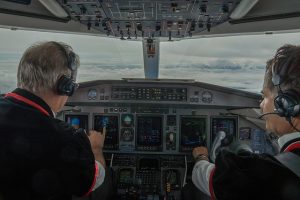
When inspecting the cockpit of a typical airplane, you may see a yoke. Also known as a control column, it’s one of the most common types of flight control systems. Yokes are essentially steering wheel-like components that allow pilots to control the airplane. Pilots can typically raise, lower and turn yokes to control the airplane.
#1) Available in Mechanical and Fly-By-Wire Styles
There are mechanical and fly-by-wire yoke styles available. Mechanical yokes are those that use a mechanical method of operation. Fly-by-wire yokes, on the other hand, use a digital method of operation. In the past, all yokes were mechanical. With that said, more and more airplanes are being designed with fly-by-wire yokes. Fly-by-wire yokes essentially use a computer to convert the yoke’s movements into commands.
#2) Typically Feature a U-Shaped Design
While you can find them in different shapes, most yokes feature a U-shaped design. Some of the first yokes ever invented featured a U-shaped design. Even today, most airplanes with yokes use this same design. There are still alternative shapes in which yokes are made, such as M-shaped and X-shaped, but U-shaped is the most common.
#3) Come in Pairs
Yokes typically come in pairs. There’s a yoke in front of the pilot’s seat, and there’s another yoke in front of the copilot’s seat. Both yokes serve the same purpose of controlling the airplane’s flight surfaces. Only one of them, however, will be engaged at any given time. If the pilot is operating his or her yoke, the copilot will refrain from touching his or her yoke.
Yoke pairs are connected. In other words, if one of the yokes moves in a particular direction, the other yoke will automatically move in the same direction — without requiring any manual action from the pilot or copilot.
#4) Side and Center Sticks Used as an Alternative
An alternative to yokes is side and center sticks. Not all airplanes have yokes in the cockpit. Some of them have side and center stocks. Side and center sticks are used for the same purpose of controlling the airplane’s flight surfaces.
#5) Supports Ancillary Functions
Most yokes support ancillary functions. Pilots can control the airplane’s flight surfaces by raising, lowering and turning them. Yokes, though, allow pilots to perform other commands. Some yokes have buttons for autopilot, whereas others have trim adjustment and flight checklist buttons.



